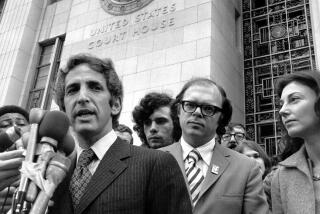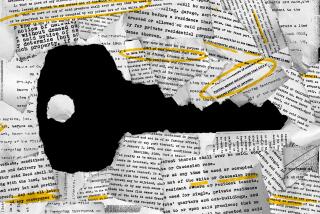Martin Ernest Dannenberg dies at 94; found copy of Nuremberg Laws during WWII
Martin Ernest Dannenberg, who as a young World War II Army sergeant discovered a copy of the anti-Semitic Nuremberg Laws, one of Nazi Germany’s most infamous documents, died Aug. 18 in his sleep at his home in Guilford, Md. He was 94.
FOR THE RECORD:
Martin Dannenberg obituary: The obituary in Friday’s LATExtra section of former Army Sgt. Martin Ernest Dannenberg, who discovered a copy of the anti-Semitic Nuremberg Laws in Germany in 1945, failed to include in the list of surviving family members his daughter, Betsy Dannenberg Frahm. —
Dannenberg, who was a special agent in charge of an Army counterintelligence team, told the Baltimore Sun in 1999 about the moment on April 28, 1945, when he realized the significance of the documents he had found in a small-town bank in Eichstatt, Germany.
What he held was a rather ordinary brown manila envelope sealed with red wax embossed with swastikas.
“I had a most peculiar feeling when I had this in my hand, that I should be the one who should uncover this,” Dannenberg said. “Because here is this thing that [begins] the persecution of the Jews. And a Jewish person has found it.”
Dannenberg carefully slit the top of the envelope and withdrew the typescript documents. The first thing he saw was Adolf Hitler’s signature.
Dannenberg was accompanied by Frank Perls — a U.S. military translator, the son of Jewish art dealers in Berlin and a refugee from Nazi Germany.
He said that tears filled Perls’ eyes when both men realized the historic implications of the document they had discovered and that it was two Jews who had found them.
A few days earlier, Dannenberg had experienced firsthand at the Dachau concentration camp the inhumane and cruel consequences of what the Nuremberg Laws had set in motion, as he gazed at the emaciated bodies, with their wide-open, lifeless eyes and hanging jaws, stacked like so many railroad ties.
With Hitler’s signature in September 1935, the Nuremberg Laws legislation formally legalized anti-Semitism and persecution of the Jews.
“Their importance,” Dannenberg said in 1999, “was that this was the ticket, you might say, for the ‘legal’ persecution of the Jews, which led to ‘Crystal Night,’ which led up to the concentration camps and the ‘Final Solution.’ ”
Hitler unveiled the content of the Nuremberg Laws at the annual Nazi Party Congress rally in Nuremberg in September 1935.
One of the more chilling edicts was the “Law for the Security of German Blood and German Honor,” which forbade marriage or extramarital intercourse between Jews and “citizens of German or German-related blood.”
The laws also excluded Jews from Reich citizenship. They also could neither vote nor hold public office.
Jews were not identified by religion but defined as anyone with three or four Jewish grandparents.
Jews who did not practice Judaism or had converted to Christianity were still considered to be Jews under the new law.
Jews were forbidden to display the German flag or German colors but were allowed under the edict to fly the Jewish colors.
“The first thought that crossed my mind was that this would be a hell of a souvenir to take back to Baltimore,” Dannenberg recalled in 1999, but he decided instead to turn it over to 3rd Army headquarters.
It was the last time Dannenberg saw the envelope for more than half a century.
The envelope eventually made its way to Gen. George S. Patton Jr., commander of the 3rd Army, who made it his personal property.
In June 1945, during a trip home to California, Patton donated the envelope to the Huntington Library.
For the next 54 years, it remained undisturbed in a library vault until being discovered and placed on public display at the Skirball Cultural Center in 1999, where Dannenberg was a guest speaker at the opening ceremony.
Steven S. Koblik, Huntington president, said Wednesday that the documents were being permanently placed in the National Archives in Washington. The Nuremberg Laws were removed from display at the Skirball late last year for analysis and conservation, said Susan Turner-Lowe, vice president for communications at the Huntington.
Dannenberg, the son of a women’s clothing manufacturer and a homemaker, was born Nov. 5, 1915, in Baltimore. He was a 1931 graduate of City College and attended Johns Hopkins University and the University of Baltimore’s law school.
Dannenberg worked 55 years with Sun Life Insurance Co. He was chairman of the board when he retired in 1987.
He is survived by his wife of 20 years, the former Margery Singer; two sons; a stepdaughter; eight grandchildren; and three great-grandchildren. His wife of 48 years, the former Esther Salzman, died in 1989.
fred.rasmussen@baltsun.com
More to Read
Start your day right
Sign up for Essential California for the L.A. Times biggest news, features and recommendations in your inbox six days a week.
You may occasionally receive promotional content from the Los Angeles Times.






